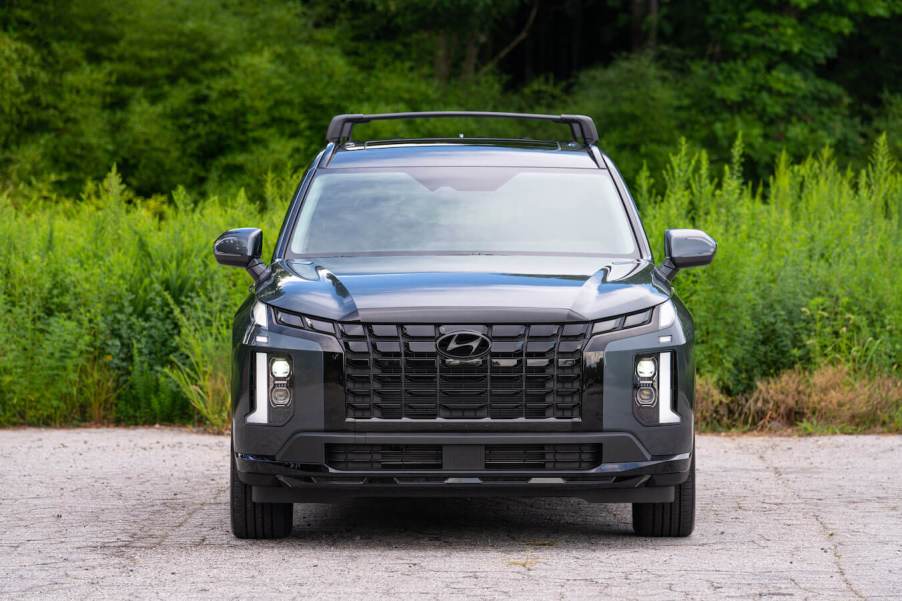
The 2023 Hyundai Palisade Is Among the Worst SUVs on 1 Updated Crash Test
The Insurance Institute for Highway Safety (IIHS) recently updated its testing procedures to include more stringent rear-passenger seat safety standards. As a result, some venerable family haulers, including the 2023 Hyundai Palisade, have shown to provide “inadequate protection” for passengers behind the front row.
Rear seatbelt technology isn’t what it needs to be

According to the IIHS, a study of vehicles from “2007 onward” showed the risk of a fatal injury is 46 percent higher for rear-seat passengers wearing a seatbelt versus front-belted passengers. The organization states rear seats haven’t become less safe; rather, “restraint technologies have only improved in the front seat.”
This most certainly impacts vehicles such as the 2022 and 2023 Hyundai Palisade.
Consumer Reports reported that most new cars include pretensioners and load limiters for front-seat passenger restraints. These technologies work in tandem to reduce the impact of a crash on a passenger’s body. However, the publication reported that only about half of mainstream cars have these features on rear seat restraints. IIHS spokesperson Joe Young told Consumer Reports that using “advanced seat belt designs” for rear passengers improves rear seat safety under the organization’s new testing procedures.
“Zeroing in on weaknesses in rear seat safety is an opportunity to make big gains in a short time, since solutions that are already proven to work in the front can successfully be adapted for the rear,” IIHS Senior Research Engineer Marcy Edwards said in a statement.
The IIHS’s updated testing aims to improve rear occupant safety
The IIHS’ updated its moderate overlap front crash test in response to figures showing higher injury rates for rear passengers. To earn a “good” rating in the updated procedure, the second-row dummy “must not exceed limits indicating an excessive risk of injury to the head, neck, chest, abdomen or thigh,” seatbelts must prevent the dummy’s head from hitting the vehicle’s interior or the front seatback or sliding forward beneath the lap belt.
Young with the IIHS told Consumer Reports the updated results do not significantly impact rear seat occupants using a forward- or rear-facing five-point child seat as they “provide a high level of crash protection.”
The Hyundai Palisade earns a ‘poor’ rating in the updated test
The 2022 and 2023 Hyundai Palisade models earned a “good” rating for front passenger safety in the updated test but was given a “poor” rating for head and neck safety for rear passengers. The IIHS notes that the Palisade’s test “indicated a high risk of head or neck injuries” for rear passengers, and the SUV had high seat belt tension for rear occupants.
A Hyundai spokesperson told Consumer Reports the company has an “aggressive plan to implement countermeasures to improve restraint technologies for rear occupant protection.”
The updated test gave the 2022 and 2023 Palisade a “moderate” rating for rear occupant chest protection and good ratings for rear passenger thigh and restraint/kinematics.
The revamped testing has impacted the Palisade’s overall scores for rear-seat passenger safety. The popular midsize three-row SUV has earned a 2023 Top Safety Pick+ designation from the IIHS, including a leading rear-seat passenger safety measure, Hyundai’s Rear Occupant Alert System. Before the updated front moderate overlap test, the Palisade earned a “good” rating from the organization for rear passenger safety.
Several other SUVs earn ‘poor’ scores
The 2023 Hyundai Palisade isn’t alone in scoring a poor rating in the IIHS’ updated procedure. The 2022 Honda Pilot, 2022-23 Jeep Grand Cherokee and four-door Jeep Wrangler, 2021-23 Mazda CX-9, and 2021-23 Nissan Murano all earned “poor” ratings in the test. The Chevrolet Traverse, Toyota Highlander, and Volkswagen Atlas from model years 2022-23 earned a “moderate” score.
Of the 13 models tested, only the 2022-23 Ford Explorer, 2021-23 Ford Mustang Mach-E, 2022-23 Subaru Ascent, and 2022-23 Tesla Model Y earned good ratings. The Mach-E was the only model with a good rating for all rear passenger injury measures.
The hope is that updated testing measures make it easier for models like the 2023 Hyundai Palisade and the other vehicles to offer the extensive protection that passengers deserve.



